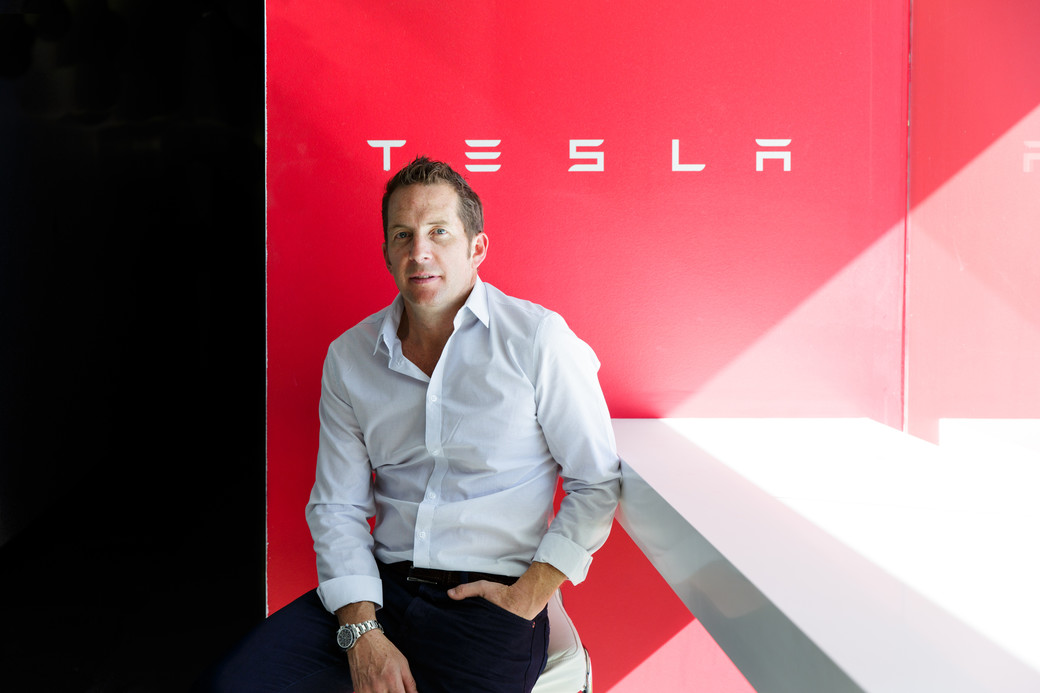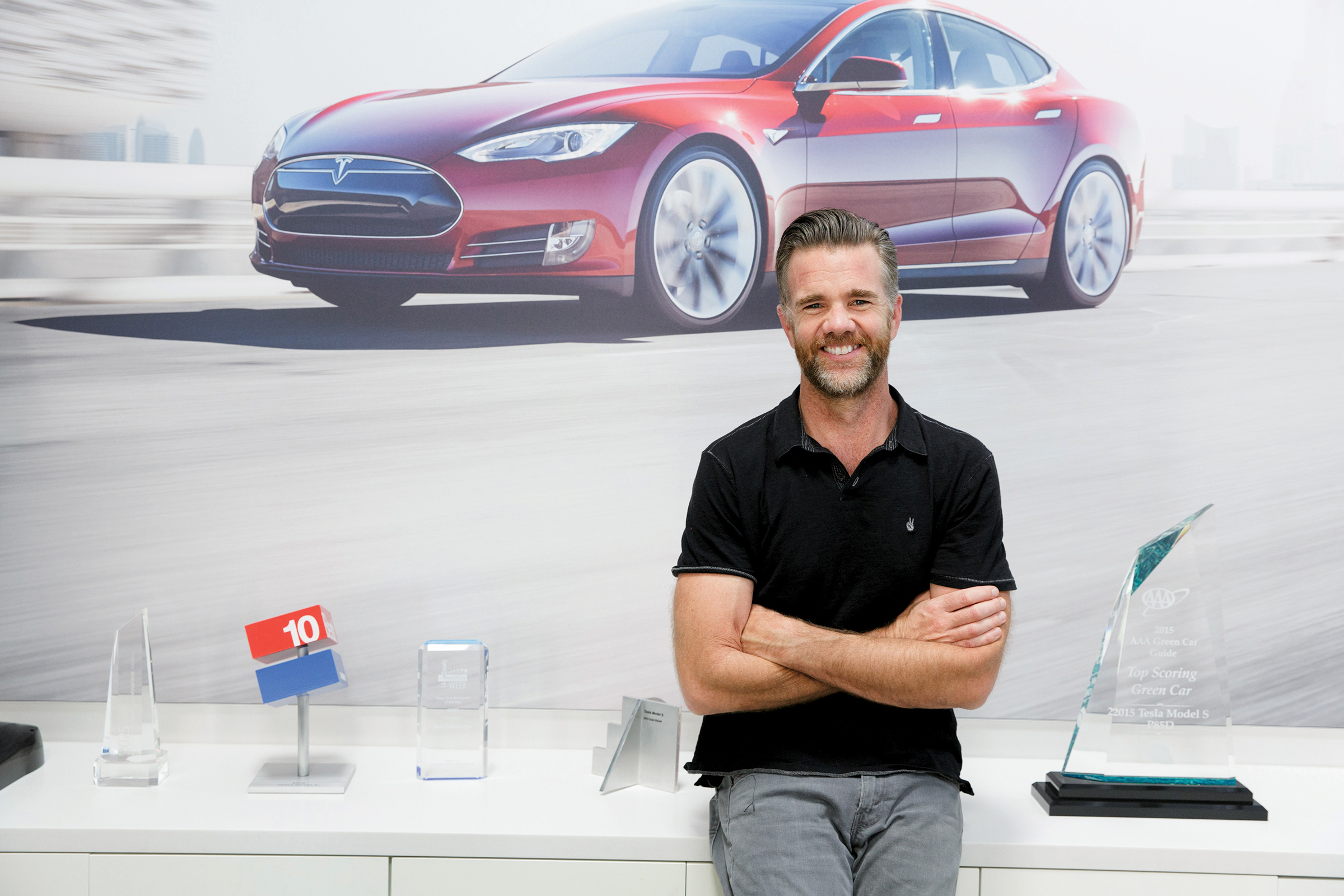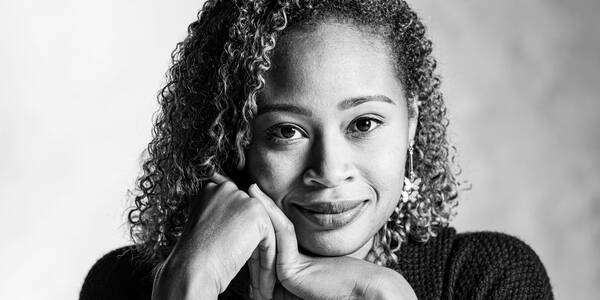feature / alumni / transportation-design
March 31, 2016
Writer: Mike Winder
Photographer: Juan Posada
Supercharged: How two former classmates are shaping the future of Tesla
As we go to press, more than 276,000 people have placed preorders for a Tesla Model 3, the highly anticipated, all-electric vehicle with a 215-mile range and an accessible $35,000 price tag—the car Tesla’s CEO Elon Musk has called “the most profound” vehicle in the company’s portfolio.
And when the Model 3 begins zipping down highways in 2018, feel free to impress upon your friends, family and neighbors that were it not for ArtCenter College of Design, that planet-saving object of beauty wouldn’t exist.
That’s because California-based Tesla is positively teeming with ArtCenter alumni in positions across the board—from its chief designer to its purchasing manager—at its design studios in Hawthorne, just south of Los Angeles, and at its manufacturing plant in Fremont, north of San Jose.

We paid a visit to the Hawthorne facility on a hot February day—the first day of a record-shattering heatwave. The highly secretive design studio operates out of a former aircraft hangar that once housed a practice court for the Los Angeles Lakers. Just a few blocks away from the childhood home of the Beach Boys, the studio sits adjacent to the Hawthorne Municipal Airport, in a no-frills neighborhood replete with taquerias and auto body shops. Outside, Tesla Superchargers are hard at work filling up a row of Model S vehicles; inside, a growing creative workforce, many of them ArtCenter alumni, are even harder at work designing the future of sustainable mobility.
How did Tesla become such a tremendous magnet for the College’s graduates and the design leadership they bring with them? To answer that question, let’s plug the way-back machine into our Tesla Powerwall (more on that later), turn the dial to 1988 and step into a classroom run by storied instructor and alumnus Ted Youngkin (BS 54 Product).

Brought to you by the letter “V”
“Before coming to ArtCenter, I had never encountered such high expectations,” says Mexico City-born Product Design alumnus and Tesla’s director of product design Javier Verdura (BS 91), when asked how the College informed his design practice. “Ted Youngkin and Joe Farrer (BS 50 Product) were two instructors who instilled a sense of precision and perfection in all their students, and I was certainly no exception.”
Verdura remembers the very moment he first discovered design. It was the day his parents took him, as a teenager, to the Rufino Tamayo Museum in Mexico City to see an exhibition of Italian industrial design from 1946 to 1986. “I knew I loved to draw cars and take things apart but I didn’t know industrial design even existed,” says Verdura. “At this exhibition, they had furniture, appliances, the Ferrari Testarossa. And I thought, This is industrial design? Are you kidding me? Where do I sign up? And that’s when I went to California to visit ArtCenter.”
Which brings us to Verdura’s first year at the College, a time when he was most likely busy learning how to make a fiberglass vessel sans air pockets, one of those seminal projects ArtCenter graduates never forget. But something far more pedestrian, in a class taught by Youngkin, was about to set Verdura’s design destiny in motion.
“Mr. Youngkin was very precise, and in order to remember his students’ names he made us sit in alphabetical order,” laughs Verdura, recalling one of his earliest College experiences. “He told us to stay in those seats for the rest of the term. So I ended up sitting next to von Holzhausen.”
That’s von Holzhausen as in Transportation Design alumnus and Tesla’s chief designer Franz von Holzhausen (BS 92). The two introduced themselves to each other and have remained good friends ever since.
“There were a lot of legendary instructors still teaching when we were there,” says von Holzhausen, as he names a few ArtCenter luminaries, including Youngkin, Farrer and Strother MacMinn (BS 35 Transportation). “I’ll never forget when Harry Bradley told me that I should quit, and that I might not have what it takes to be a car designer.”
That elicits a big laugh between von Holzhausen and Verdura. “That guy really had a crystal ball,” says Verdura, who adds that Andy Ogden (BS 83 Transportation), current chair of the Graduate Industrial Design program, was one of the best instructors he ever had.
“A lot of those older guys like Youngkin were tough, but that’s how they made sure we would survive in the real world,” says von Holzhausen. “They were getting us ready.”

Two paths, one destination
When it comes to transportation design, you can’t get much bigger than von Holzhausen. After graduating from ArtCenter, his career took him from being chief designer at Volkswagen in 1992 (he saw the New Beetle through to production), to design director at General Motors in 2000 (Autoweek called his Pontiac Solstice roadster a “much needed shot in the arm” for the Detroit automaker), to director of design at Mazda in 2005 (Top Gear recently listed his Kabura sports coupe as one of “Mazda’s coolest ever concept cars”).
In 2008, von Holzhausen was wooed to Tesla personally by Musk, the company’s charismatic and visionary leader, who immediately tasked him with designing the all-electric Model S, a car which, since its release, has won countless awards and earned Consumer Reports’ highest rating ever. Arguably the world’s sexiest vehicle, the Model S is aerodynamic (complete with retracting door handles), ludicrously fast (0 to 60 mph in 2.8 seconds), and über high tech (a recent over-the-air software update enabled an “Autopilot” feature), and its timeless, just-the-essentials aesthetic is redefining what consumers expect from a luxury vehicle. But most importantly, it has set the tone for what all future Tesla vehicles will deliver in terms of both design and functionality—including the forthcoming Model 3.
Verdura followed a much different career trajectory. Immediately after graduating in 1991, he became senior designer for consultancy Group 4 Design in Avon, Connecticut, working with clients like Ingersoll-Rand, Kodak and Panasonic. In 1995, he became design manager at the then-Atlanta-based consultancy Inno Design. And in 1998, he returned to the Constitution State to become vice president of industrial design and development for consultancy firm Product Ventures, working with clients in the fields of surgical equipment, consumer products and packaging.
The years went by and though they were separated by 2,500 miles, Verdura and von Holzhausen remained close. So when von Holzhausen called his friend in 2012 and asked him if he’d like to become Tesla’s director of product design, Verdura embraced the opportunity. “Franz is one of the greatest car designers of our generation,” says Verdura, who breaks down their duties as follows: “On a day-to-day basis, he focuses on what he excels at—designing cars—and he lets me play with all the other stuff.”

All the other stuff
Think Tesla is a car company? Think again. Sure, they make one of the most coveted vehicles on the planet, but that’s not the company’s goal. Tesla is first and foremost a technology-driven company, and its technological goal is to break the world’s addiction to fossil fuels and promote the advent of worldwide sustainable mobility. Which is one reason why Tesla makes its patents open source. Verdura sums up Elon Musk’s philosophy like this: “We’re all on a sinking ship, and yes, while we have the best bucket, we’re also going to teach others how to build that bucket.”
What’s the first bucket in Tesla’s arsenal? Creating a new class of transportation – premium and desirable electric vehicles. And for Tesla, that means more than just designing beautiful automobiles. It means providing free and convenient energy to power those vehicles. “Imagine if Henry Ford, who revolutionized mass-production of automobiles at the turn of the century, had also endeavored to build gas stations to fuel his customers’ cars for free,” says Verdura of Tesla’s proprietary Supercharger stations, the first project he worked on when coming back to California, which provide 170 miles of range in as little as 30 minutes of charging. “And by creating this network of Superchargers, we’re removing the single biggest obstacle people have towards purchasing an electric vehicle: range anxiety. Our customers don’t have to ask, 'Where will I charge the car? What if it takes too long? What if I run out of energy?'”
The company’s disruptive ambitions don’t end there. This summer, you should be able to purchase the next version of Tesla’s Powerwall, a rechargeable battery pack which the company first released last year. “It’s a beautiful sculpture-like battery that you hang in your garage, like a flat screen TV,” says Verdura. He explains how the device stores energy from your home’s solar panels and allows you to use that same energy later in the evening during peak (read: most expensive) times. “You can almost be completely off the grid with that battery and solar panels. It’s a clear win-win.”
Then there’s a whole other pool in which Tesla’s designers get to dip their toes—space exploration. Musk’s private space exploration company, SpaceX, whose goal is no less ambitious than to put a human on the surface of Mars by 2025, is Tesla’s next-door neighbor in Hawthorne. In the past, the company has turned to von Holzhausen’s group to design objects ranging from spacesuits to the interiors of manned space capsules. “It’s simply amazing to be in the same room as Elon and to hear the things that come out of his mouth,” says Verdura, describing the unbelievable nature of his job. “I hear what he’s saying and I think, That’s impossible. We can’t do that. And then we do it!”
Two seats and a steering wheel
Not surprisingly, for a company with one foot firmly planted in the future, Tesla knows things are changing dramatically. The era of self-driving cars will be here soon, and ride-sharing services like Uber are undoubtedly only going to grow in popularity. The combination of ride-sharing services and autonomous cars could have a significant impact on pollution and congestion in the world’s most populous cities—all of which gels nicely with Tesla’s ultimate goal of eliminating the use of fossil fuels.
As beautiful as the Model S and Model 3 are, they still fall within the familiar “two seats and a steering wheel” category of transportation. But as we enter an autonomous and fossil fuel-free future, many things the public is accustomed to in mobility will be upended.
And when they are, you can bet Tesla, and its many ArtCenter alumni employees, will be there in the driver’s seat, disrupting things for us all.








